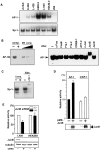AP-1 mediated relief of repressive activity of the CD30 promoter microsatellite in Hodgkin and Reed-Sternberg cells
- PMID: 12875982
- PMCID: PMC1868231
- DOI: 10.1016/S0002-9440(10)63690-5
AP-1 mediated relief of repressive activity of the CD30 promoter microsatellite in Hodgkin and Reed-Sternberg cells
Abstract
Overexpression of CD30 is the hallmark of Hodgkin and Reed-Sternberg (H-RS) cells and drives constitutive nuclear factor-kappaB activation that is the molecular basis for the pathophysiology of Hodgkin's lymphoma. Transcription of the CD30 gene is controlled by the core promoter that is driven by Sp-1 and the microsatellite sequences (MSs) that represses core promoter activity. To understand the mechanism(s) of CD30 overexpression in H-RS cells, we structurally and functionally characterized the CD30 MSs. Although the CD30 MS of H-RS cell lines was polymorphic, it was not truncated compared with that of control cells. A strong core promoter activity and constitutive Sp-1 binding were revealed in all cell lines examined irrespective of the levels of CD30 expression. In transient reporter gene assays, all MS clones derived from H-RS cell lines repressed the core promoter activity in unrelated cell lines, but not in the H-RS cell lines. An AP-1-binding site was found in the MS at nucleotide position of -377 to -371, the presence of which was found to relieve repression of the core promoter in H-RS cell lines but not in other tumor cell lines. H-RS cell lines showed constitutive and strong AP-1-binding activity, but other cell lines did not. The AP-1 complex contained JunB, whose overexpression activated reporter constructs driven by the CD30 promoter including the MSs, and was dependent on the AP-1 site. JunB expression was detected in H-RS cells in vitro and in vivo, but not in reactive cells or tumor cells of non-Hodgkin's lymphoma of diffuse large B-cell type. Transduction of JunB small interfering RNAs suppressed CD30 promoter activity in L428 cells but not in control cells. Taken together, overexpression and binding of JunB to the AP-1 site appear to relieve the repression of the core promoter by the CD30 MS in H-RS cells, which provide one basis for the constitutive overexpression of CD30 in Hodgkin's lymphoma.
Figures





Similar articles
-
JunB induced by constitutive CD30-extracellular signal-regulated kinase 1/2 mitogen-activated protein kinase signaling activates the CD30 promoter in anaplastic large cell lymphoma and reed-sternberg cells of Hodgkin lymphoma.Cancer Res. 2005 Sep 1;65(17):7628-34. doi: 10.1158/0008-5472.CAN-05-0925. Cancer Res. 2005. PMID: 16140928
-
Ligand-independent signaling by overexpressed CD30 drives NF-kappaB activation in Hodgkin-Reed-Sternberg cells.Oncogene. 2002 Apr 11;21(16):2493-503. doi: 10.1038/sj.onc.1205337. Oncogene. 2002. PMID: 11971184
-
Aberrant NF-kappaB2/p52 expression in Hodgkin/Reed-Sternberg cells and CD30-transformed rat fibroblasts.Oncogene. 2005 Jun 2;24(24):3976-86. doi: 10.1038/sj.onc.1208564. Oncogene. 2005. PMID: 15782119
-
CD30 in normal and neoplastic cells.Clin Immunol. 1999 Feb;90(2):157-64. doi: 10.1006/clim.1998.4636. Clin Immunol. 1999. PMID: 10080826 Review.
-
The biological basis of Hodgkin's lymphoma.Drug News Perspect. 2003 Dec;16(10):649-56. doi: 10.1358/dnp.2003.16.10.829295. Drug News Perspect. 2003. PMID: 14747844 Review.
Cited by
-
Ets-1 activates overexpression of JunB and CD30 in Hodgkin's lymphoma and anaplastic large-cell lymphoma.Am J Pathol. 2012 Feb;180(2):831-8. doi: 10.1016/j.ajpath.2011.10.007. Epub 2011 Nov 19. Am J Pathol. 2012. PMID: 22107829 Free PMC article.
-
CD30 Expression and Its Functions during the Disease Progression of Adult T-Cell Leukemia/Lymphoma.Int J Mol Sci. 2023 May 13;24(10):8731. doi: 10.3390/ijms24108731. Int J Mol Sci. 2023. PMID: 37240076 Free PMC article. Review.
-
Rapid generation of long synthetic tandem repeats and its application for analysis in human artificial chromosome formation.Nucleic Acids Res. 2005 Sep 1;33(15):e130. doi: 10.1093/nar/gni129. Nucleic Acids Res. 2005. PMID: 16141190 Free PMC article.
-
CAR-T Cell Therapy for Classical Hodgkin Lymphoma.Hemasphere. 2023 Nov 16;7(12):e971. doi: 10.1097/HS9.0000000000000971. eCollection 2023 Dec. Hemasphere. 2023. PMID: 38026793 Free PMC article. Review.
-
Understanding CD30 biology and therapeutic targeting: a historical perspective providing insight into future directions.Blood Cancer J. 2017 Sep 8;7(9):e603. doi: 10.1038/bcj.2017.85. Blood Cancer J. 2017. PMID: 28885612 Free PMC article. Review.
References
-
- Gruss HJ, Kadin ME: Pathophysiology of Hodgkin’s disease: functional and molecular aspects. Baillieres Clin Haematol 1996, 9:417-446 - PubMed
-
- Cossman J, Annunziata CM, Barash S, Staudt L, Dillon P, He WW, Ricciardi-Castagnoli P, Rosen CA, Carter KC: Reed-Sternberg cell genome expression supports a B-cell lineage. Blood 1999, 94:411-416 - PubMed
-
- Kuppers R, Rajewsky K: The origin of Hodgkin and Reed/Sternberg cells in Hodgkin’s disease. Annu Rev Immunol 1998, 16:471-493 - PubMed
-
- Kuppers R, Rajewsky K, Zhao M, Simons G, Laumann R, Fischer R, Hansmann ML: Hodgkin disease: Hodgkin and Reed-Sternberg cells picked from histological sections show clonal immunoglobulin gene rearrangements and appear to be derived from B cells at various stages of development. Proc Natl Acad Sci USA 1994, 91:10962-10966 - PMC - PubMed
Publication types
MeSH terms
Substances
LinkOut - more resources
Full Text Sources
Medical

